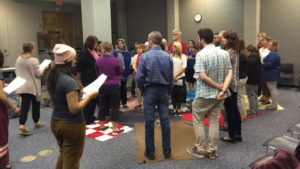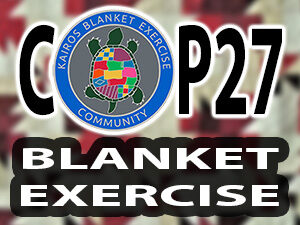Blanket Exercise unfurls Indigenous history for Saskatoon leaders

The City of Saskatoon recently hosted a blanket exercise for a group of community leaders. (Submitted by Neal Kewistep)
‘Often there’s a lot of guilt and shame that comes up,’ says activity leader
The City of Saskatoon is using blankets to unfurl the history of colonization in Canada.
As part of the city’s wider goals of advancing reconciliation, it recently hosted a “blanket exercise” to teach community leaders about colonization.
Delivered by the Canadian Roots Exchange, the activity uses blankets to demonstrate how Indigenous communities were displaced.
The blankets are laid out on the floor to symbolize the land mass of Canada. Participants are asked to stand on them, representing Indigenous groups throughout history.

The blanket exercise, which uses blankets to teach the history of colonization in Canada, sometimes evokes an emotional response from participants. (Photo submitted by Neal Kewistep)
Lives displaced
As the workshop covers historical events like the Sixties Scoop and the establishment of residential schools, some of the blankets are rolled up.
“You watch as these blankets get smaller and smaller, and more separate from each other and people get kicked off the blankets,” said Jessica Alegria, who facilitates the exercise in Saskatoon.
“People pass away and are asked to remove themselves from the exercise entirely, so that’s a really strong element of it, is the visual.”
The exercise was developed by faith-based human rights group KAIROS Canada and covers more than 500 years of history.
Emotional response
Through her role at the Canadian Roots Exchange, Alegria hosts the activity with a range of age groups and the response is often emotional.
She said young people were generally more aware of the history of colonization in Canada.
“With older participants, a lot of them weren’t quite as exposed through school,” said Alegria.
“It’s particularly difficult, I find, for people who were around in the ’60s and maybe were around when residential schools were at their height and had no idea.
“So often there’s a lot of guilt and shame that comes up.”
Alegria said the exercise was to promote healing.

Canadian Roots Exchange program facilitator Jessica Alegria says the blanket exercise has a strong visual element. (Steve Pasqualotto/CBC)
Steps to reconciliation
City of Saskatoon Aboriginal relations director Gilles Dorval said it was important community leaders and decision-makers knew the full history of colonization.
“The curriculum and social studies wasn’t like it is today so we really have to provide the information to those individuals to help them make decisions,” said Dorval.
He said some of the religious organizations that operated residential schools in Saskatchewan were also supporting the city.
By Alicia Bridges, CBC News Posted: Sep 20, 2016 4:01 PM CT





